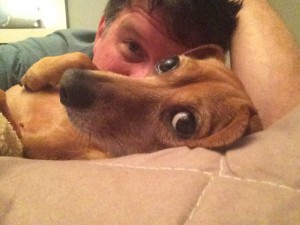Back in graduate school for becoming a counselor we had to write a position paper that addressed a pivotal question. Are people inherently good or are we flawed, destined by our very nature to ill will, crime, and other malfeasance? We then had to explore how the answer to that one question would likely shape our approaches to being a counselor and our techniques with our clients. It turns out I didn’t become a counselor. Still, the question resonates with me to this day, and it applies to our work with dogs.
 Are our dogs, all dogs, inherently good? Or is their nature flawed, dooming them to misbehavior and conflict with us humans? I’ll skip to the end here. People: good. Dogs: also good.
Are our dogs, all dogs, inherently good? Or is their nature flawed, dooming them to misbehavior and conflict with us humans? I’ll skip to the end here. People: good. Dogs: also good.
But let me explain this thinking a bit further. I’m not talking about good versus evil. In the movies dogs are cast as moral icons. For a lot of people that image is comforting, dogs as spiritual exemplars. That’s a shame, though, and a disservice to dogs who are natural thinking and feeling beings. Like all beings (even human beings) they make choices – they choose behaviors that keep them safe and serve their needs. We like many of the choices our dogs make (and we call them good choices). Some we don’t. But none of that has any bearing on the goodness of dogs, born of dogs into our human world. It’s not up to us to assign any higher value to them. The dog is what he is and that’s enough. Good enough.
Dogs think (and learn). They feel. They perceive. They communicate. They engage their bodies with the world around them in work, play, and rest. All good.
So much of the time, the problem with dogs is ours. It begins in our own heads. We have this idea of good and we try, despite evidence of our folly, to plaster it onto our dogs. Good dogs, we say, think just like us. They jockey for power and adulation, like us. They fall victim to brooding over emotions like us. They see the world like us and understand words (sentences) like us. Their bodies are to be tempered, controlled, as we try (and fail) to control our bodies. It’s how we think of our dogs all too often. All wrong.
There are volumes written about the nature of dogs. I won’t do them justice here. But when we think about the real goodness of dogs, as they are not as we press them to be, then we begin to honor one of the world’s most amazing animals. They think and feel. There is new evidence emerging even now about how vibrant our dogs’ mental and emotional lives might actually be. They take in the world through all their senses, but most especially their noses. It’s a rich perception of the environment we can’t even begin to fully imagine with our ocular and auditory brains. They interact with other species, not just other dogs, with a rich vocabulary of body movements and facial expressions (we’d serve ourselves well to learn this language of dogs). And, they are physical, beautifully physical, athletic, elegantly so – and also calm at times, even languid, eager to cuddle and pleasing to touch.
How can we think of engaging these animals with anything other than deep admiration and respect? Exploring the goodness of dogs always leads back to this. They’re cool. There is so much to them. And the more we look the more we notice how much more there is. Our ideas of good dog and bad dog pale when we begin to see what they really are. And, so our choices are naturally shaped by the goodness at hand.
We teach dogs kindly in a way that honors their intelligence and emotional lives. This is how the question of goodness leads us to how we approach dogs and the techniques we use in teaching and communicating. Shame on us who impose our own damaged view of the world on to them. More shame if that view leads us to hurt them as perhaps we are hurting. We humans are stuck in a constant loop of need, to feel good, to feel in control, to achieve and flaunt. Not so our dogs. Better to take a breath and notice who they are than to put that on them. Listen by watching. Take in how they take in the world. Get lost in their motion, the subtle move of their eyes and ears. Be the quiet primate and move with equal measure of subtlety to a common ground.
The person and the dog, it is the stuff of stories, no dramatic embellishment needed. Here’s to finding our own human goodness, better still shared with another.
